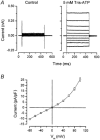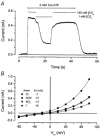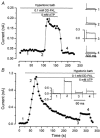A novel chloride conductance activated by extracellular ATP in mouse parotid acinar cells
- PMID: 12562938
- PMCID: PMC2342604
- DOI: 10.1113/jphysiol.2002.028373
A novel chloride conductance activated by extracellular ATP in mouse parotid acinar cells
Abstract
Salivary gland fluid secretion is driven by transepithelial Cl- movement involving an apical Cl- channel whose molecular identity remains unknown. Extracellular ATP (ATP(o)) has been shown to activate a Cl- conductance (I(ATPCl)) in secretory epithelia; to gain further insight into I(ATPCl) in mouse parotid acinar cells, we investigated the effects of ATP(o) using the whole-cell patch-clamp technique. ATP(o) and 2'- and 3'-O-(4-benzoylbenzoyl)adenosine 5'-triphosphate triethylammonium salt (Bz-ATP) produced concentration-dependent, time-independent Cl- currents with an EC50 of 160 and 15 microM, respectively. I(ATPCl) displayed a selectivity sequence of SCN- > I- = NO3- > Cl- > glutamate, similar to the Cl- channels activated by Ca2+, cAMP and cell swelling in acinar cells. In contrast, I(ATPCl) was insensitive to pharmacological agents that are known to inhibit these latter Cl- channels, was independent of Ca2+ and was not regulated by cell volume. Moreover, the I(ATPCl) magnitude from wild-type animals was comparable to that from mice with null mutations in the Cftr, Clcn3 and Clcn2 Cl- channel genes. Taken together, our results demonstrate that I(ATPCl) is distinct from the channels described previously in acinar cells. The activation of I(ATPCl) by Bz-ATP suggests that P2 nucleotide receptors are involved. However, inhibition of G-protein activation with GDP-beta-S failed to block I(ATPCl), and Cibacron Blue 3GA and 4,4'-diisothyocyanostilbene-2,2'-disulphonic disodium salt selectively inhibited the Na+ currents (presumably through P2X receptors) without altering I(ATPCl), suggesting that neither P2Y nor P2X receptors are likely to be involved in I(ATPCl) activation. We conclude that I(ATPCl) is not associated with Cl- channels previously characterized in mouse parotid acinar cells, nor is it dependent on P2 nucleotide receptor stimulation. I(ATPCl) expressed in acinar cells reflects the activation of a novel ATP-gated Cl- channel that may play an important physiological role in salivary gland fluid secretion.
Figures







Comment in
-
ATP regulation of epithelial Cl- channels--new challenges?J Physiol. 2003 Feb 15;547(Pt 1):1. doi: 10.1113/jphysiol.2002.038281. Epub 2003 Jan 17. J Physiol. 2003. PMID: 12562914 Free PMC article. Review. No abstract available.
Similar articles
-
Na+ modulates anion permeation and block of P2X7 receptors from mouse parotid glands.J Membr Biol. 2008 May;223(2):73-85. doi: 10.1007/s00232-008-9115-7. Epub 2008 Jul 1. J Membr Biol. 2008. PMID: 18592294 Free PMC article.
-
A bicarbonate- and weak acid-permeable chloride conductance controlled by cytosolic Ca2+ and ATP in rat submandibular acinar cells.J Membr Biol. 1996 Sep;153(2):147-59. doi: 10.1007/s002329900118. J Membr Biol. 1996. PMID: 8703204
-
cAMP-activated anion conductance is associated with expression of CFTR in neonatal mouse cardiac myocytes.Am J Physiol Cell Physiol. 2000 Feb;278(2):C436-50. doi: 10.1152/ajpcell.2000.278.2.C436. Am J Physiol Cell Physiol. 2000. PMID: 10666040
-
Chloride channels and salivary gland function.Crit Rev Oral Biol Med. 1999;10(2):199-209. doi: 10.1177/10454411990100020601. Crit Rev Oral Biol Med. 1999. PMID: 10759422 Review.
-
Elevation of [Ca2+]i and the activation of ion channels and fluxes by extracellular ATP and phospholipase C-linked agonists in rat parotid acinar cells.Ann N Y Acad Sci. 1990;603:76-90; discussion 91-2. doi: 10.1111/j.1749-6632.1990.tb37663.x. Ann N Y Acad Sci. 1990. PMID: 1705402 Review.
Cited by
-
Otopetrin 1 activation by purinergic nucleotides regulates intracellular calcium.Proc Natl Acad Sci U S A. 2007 Jul 17;104(29):12023-8. doi: 10.1073/pnas.0705182104. Epub 2007 Jul 2. Proc Natl Acad Sci U S A. 2007. PMID: 17606897 Free PMC article.
-
Na+ modulates anion permeation and block of P2X7 receptors from mouse parotid glands.J Membr Biol. 2008 May;223(2):73-85. doi: 10.1007/s00232-008-9115-7. Epub 2008 Jul 1. J Membr Biol. 2008. PMID: 18592294 Free PMC article.
-
ATP regulation of epithelial Cl- channels--new challenges?J Physiol. 2003 Feb 15;547(Pt 1):1. doi: 10.1113/jphysiol.2002.038281. Epub 2003 Jan 17. J Physiol. 2003. PMID: 12562914 Free PMC article. Review. No abstract available.
-
Purinergic signalling in the gastrointestinal tract and related organs in health and disease.Purinergic Signal. 2014 Mar;10(1):3-50. doi: 10.1007/s11302-013-9397-9. Epub 2013 Dec 4. Purinergic Signal. 2014. PMID: 24307520 Free PMC article. Review.
-
Homodimeric anoctamin-1, but not homodimeric anoctamin-6, is activated by calcium increases mediated by the P2Y1 and P2X7 receptors.Pflugers Arch. 2015 Oct;467(10):2121-40. doi: 10.1007/s00424-015-1687-3. Epub 2015 Jan 17. Pflugers Arch. 2015. PMID: 25592660
References
-
- Begenisich T, Melvin JE. Regulation of chloride channels in secretory epithelia. J Memb Biol. 1998;163:77–85. - PubMed
Publication types
MeSH terms
Substances
Grants and funding
LinkOut - more resources
Full Text Sources
Other Literature Sources
Miscellaneous

